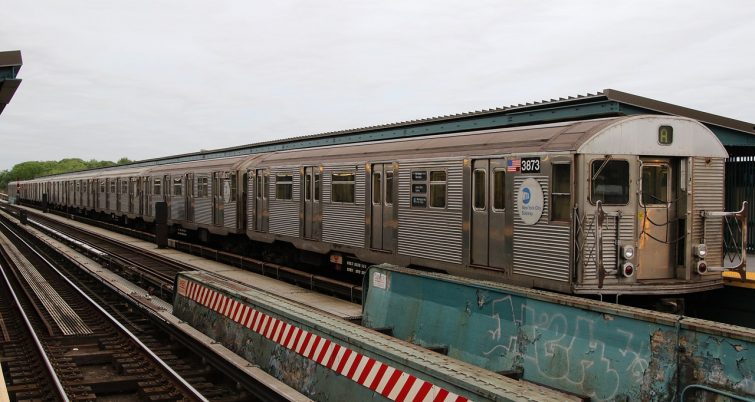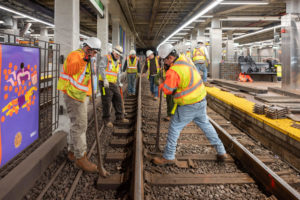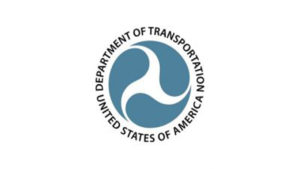MTA announces critical track replacement work will be completed two weeks ahead of schedule
Written by David C. Lester, Editor-in-Chief
Metropolitan Transportation Authority (MTA) Construction & Development President Janno Lieber today announced that the second phase of work to replace and install over 6,300 feet of track and over 9,800 feet of third rail at or near two stations at the end of the  subway line in Queens will be completed ahead of schedule and on budget. The project, originally expected to finish in mid-December, will now wrap up on Nov. 30.
subway line in Queens will be completed ahead of schedule and on budget. The project, originally expected to finish in mid-December, will now wrap up on Nov. 30.
The existing track had reached the end of its useful life and required complete replacement, which will lead to improved reliability and better service throughout the line in Queens and Manhattan. Since 2016, there have been 46 incidents between Jamaica-Van Wyck and Jamaica Center on the  subway line because of track conditions, resulting in 713 delayed trains.
subway line because of track conditions, resulting in 713 delayed trains.
“Even before the COVID-19 pandemic, the MTA had begun transforming the way we do construction – and we brought that new approach to what we did here on the  line in Southeast Queens,” said Lieber. “We are taking advantage of the low ridership during COVID to get more work done, and to complete it faster. And more projects than ever before are being completed ahead of schedule and on budget. But to keep making progress in rebuilding the system, we need help from the federal government.”
line in Southeast Queens,” said Lieber. “We are taking advantage of the low ridership during COVID to get more work done, and to complete it faster. And more projects than ever before are being completed ahead of schedule and on budget. But to keep making progress in rebuilding the system, we need help from the federal government.”
“As riders continue to return to the subways, projects like this will ensure a smoother ride with fewer delays for years to come,” said Sarah Feinberg, NYC Transit Interim President. “I am grateful to our team that worked hard to make sure community members in Southeast Queens were aware of their alternate travel options throughout the project.”
“I applaud the MTA for rapidly completing their project ahead of schedule on the  train, limiting inconvenience for Southeast Queens commuters while performing the much-needed track replacement,” said Rep. Gregory W. Meeks. “While suspended service is never easy, the community outreach was critical in keeping our community informed and prepared for these service changes. However, the lack of revenue caused by COVID threatens these necessary projects, and I will continue fighting in Congress to secure emergency federal funding for the MTA.”
train, limiting inconvenience for Southeast Queens commuters while performing the much-needed track replacement,” said Rep. Gregory W. Meeks. “While suspended service is never easy, the community outreach was critical in keeping our community informed and prepared for these service changes. However, the lack of revenue caused by COVID threatens these necessary projects, and I will continue fighting in Congress to secure emergency federal funding for the MTA.”
“I thank the MTA for not only wrapping up this project ahead of schedule, but also for working with locally elected leaders and Southeast Queens transit riders to cross honor tickets and implement alternative service via temporary shuttle buses and the LIRR during construction,” said Senator Leroy Comrie. “This experience demonstrates the MTA’s ability to meet the demands of riders while completing necessary infrastructure repair and modernization projects.”
“Southeast Queens residents are so resilient, that they stayed the course and allowed the MTA to do the much necessary work on our  train service during a pandemic,” said Assemblymember Alicia Hyndman. “The gift for their patience is full train service almost two weeks before the anticipated deadline. Thank you to the MTA and their hard workers for ensuring SEQ constituents can get back on track efficiently.”
train service during a pandemic,” said Assemblymember Alicia Hyndman. “The gift for their patience is full train service almost two weeks before the anticipated deadline. Thank you to the MTA and their hard workers for ensuring SEQ constituents can get back on track efficiently.”
“We are pleased that this important track replacement work is finishing ahead of schedule and transit riders can now resume their usual routines,” said Council Member I. Daneek Miller. “Any suspension in service at a major transit thoroughfare such as this can be difficult, but thanks to the working partnership with the MTA, our local elected offices, and community partners, we are confident that riders had sufficient alternate transit options, including cross-honoring on the LIRR.”
Phase 1 of the project was completed ahead of schedule in October, which allowed for an acceleration of Phase 2 work and limited train service at Sutphin Blvd/Archer Av-JFK and Jamaica Center-Parsons/Archer on Nov. 2.
The MTA accelerated this project’s timeline from later in the 2020-24 Capital Program to take advantage of low airport travel and low general subway ridership due to the COVID-19 pandemic, minimizing the disruption of the work and impacting fewer riders.
Read more about passenger rail.





